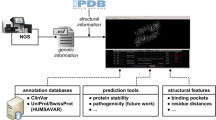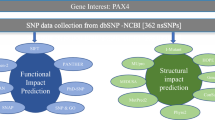Abstract
Understanding and predicting the significance of novel genetic variants revealed by DNA sequencing is a major challenge to integrate and interpret in medical genetics with medical practice. Recent studies have afforded significant advances in characterization and predicting the association of single nucleotide polymorphisms in human TERT with various disorders, but the results remain inconclusive. In this context, a comparative study between disease causing and novel mutations in hTERT gene was performed computationally. Out of 59 missense mutations, five variants were predicted to be less stable with the most deleterious effect on hTERT gene by in silico tools, in which two mutations (L584W and M970T) were not previously reported to be involved in any of the human disorders. To get insight into the structural and functional impact due to the mutation, docking study and interaction analysis was performed followed by 6 ns molecular dynamics simulation. These results may provide new perspectives for the targeted drug discovery in the coming future.






Similar content being viewed by others
References
Richards CS, Bale S, Bellissimo DB (2006) ACMG recommendations for standards for interpretation and reporting of sequence variations: revisions 2007. Genet Med 10:294–300
Wellcome Trust Case Control Consortium (2007) Genome-wide association study of 14,000 cases of seven common diseases and 3,000 shared controls. Nature. 447:661–78
Cargill M, Altshuler D, Ireland J, Sklar P, Ardlie K, Patil N, Shaw N, Lane CR, Lim EP, Kalyanaraman N, Nemesh J, Ziaugra L, Friedland L, Rolfe A, Warrington J, Lipshutz R, Daley GQ, Lander ES (1999) Characterization of single-nucleotide polymorphisms in coding regions of human genes. Nat Genet 22:231–238
Nadeau JH (2002) Single nucleotide polymorphisms: tackling complexity. Nature 420:517–518
Ramensky V, Bork P, Sunyaev S (2002) Human non-synonymous SNPs: server and survey. Nucleic Acids Res 30:3894–3900
Smith LL, Coller HA, Roberts JM (2003) Telomerase modulates expression of growth-controlling genes and enhances cell proliferation. Nat Cell Biol 5:474–479
Lee J, Sung YH, Cheong C, Choi YS, Jeon HK (2008) TERT promotes cellular and organismal survival independently of telomerase activity. Oncogene 27:3754–3760
Wong JMY, Collins K (2003) Telomere maintenance and disease. Lancet 362:983–988
Hug N, Lingner J (2006) Telomere length homeostasis. Chromosoma 115:413–425
Chen JL, Greider CW (2003) Determinants in mammalian telomerase RNA that mediate enzyme processivity and cross-species incompatibility. EMBO J 22:304–314
Ly H (2009) Genetic and environmental factors influencing human diseases with telomere dysfunction. Int J Clin Exp Med 2:114–130
Chen JL, Greider CW (2004) Telomerase RNA structure and function: implications for dyskeratosis congenita. Trends Biochem Sci 29:183–192
Armanios MY, Chen JJ, Cogan JD, Alder JK, Ingersoll RG, Markin C, Lawson WE, Xie M, Vulto I, Phillips JA 3rd, Lansdorp PM, Greider CW, Loyd JE (2007) Telomerase mutations in families with idiopathic pulmonary fibrosis. N Engl J Med 356:1317–1326
Calado RT, Regal JA, Hills M, Yewdell WT, Dalmazzo LF, Zago MA, Lansdorp PM, Hogge D, Chanock SJ, Estey EH, Falcão RP, Young NS (2009) Constitutional hypomorphic telomerase mutations in patients with acute myeloid leukemia. Proc Natl Acad Sci U S A 6:1187–1192
Yamaguchi H, Calado RT, Ly H (2005) Mutations in TERT, the gene for telomerase reverse transcriptase, in aplastic anemia. N Engl J Med 352:1413–1424
Xin ZT, Beauchamp AD, Calado RT (2007) Functional characterization of natural telomerase mutations found in patients with hematologic disorders. Blood 109:524–532
Kirwan M, Vulliamy T, Marrone A (2009) Defining the pathogenic role of telomerase mutations in myelodysplastic syndrome and acute myeloid leukemia. Hum Mutat 30:1567–1573
Vulliamy TJ, Marrone A, Knight SW (2006) Mutations in dyskeratosis congenita: their impact on telomere length and the diversity of clinical presentation. Blood 107:2680–2685
Marrone A, Walne A, Tamary H (2007) Telomerase reverse-transcriptase homozygous mutations in autosomal recessive dyskeratosis congenita and Hoyeraal-Hreidarsson syndrome. Blood 110:4198–4205
Tsakiri KD, Cronkhite JT, Kuan PJ, Xing C, Raghu G, Weissler JC, Rosenblatt RL, Shay JW, Garcia CK (2007) Adult-onset pulmonary fibrosis caused by mutations in telomerase. Proc Natl Acad Sci U S A 104:7552–7557
Kumar P, Henikoff AS, Ng PC (2009) Predicting the effects of coding non-synonymous variants on protein function using the SIFT algorithm. Nat Protoc 4:1073–1081
Adzhubei IA, Schmidt S, Peshkin L (2010) A method and server for predicting damaging missense mutations. Nat Methods 7:248–249
Capriotti E, Fariselli P, Casadio R (2005) I-Mutant 2.0: predicting stability changes upon mutation from the protein sequence or structure. Nucleic Acids Res 33:306–310
Bordoli L, Kiefer F, Arnold K (2009) Protein structure homology modeling using SWISS-MODEL workspace. Nat Protoc 4:1–13
Lee JH, Chung IK (2010) Curcumin inhibits nuclear localization of telomerase by dissociating the Hsp90 co-chaperone p23 from hTERT. Cancer Lett 290:76–86
Sherry ST, Ward M, Sirotkin K (1999) dbSNP-Database for Single Nucleotide Polymorphisms and other classes of minor genetic variation. Genome Res 9:677–679
Bairoch A, Apweiler R (1996) The SWISS-PROT protein sequence data bank and its new supplement TREMBL. Nucleic Acids Res 24:21–25
Podlevsky JD, Bley CJ, Omana RV, Qi X, Chen JJ (2007) The telomerase database. Nucleic Acids Res 36:339–D343
Lovell SC, Davis IW, Arendall WB 3rd, de Bakker PI, Word JM, Prisant MG, Richardson JS, Richardson DC (2002) Structure validation by Calpha geometry: phi, psi and Cbeta deviation. Proteins 50:437–450
Guex N, Peitsch MC (1997) SWISS-MODEL and the Swiss-PdbViewer: an environment for comparative protein modeling. Electrophoresis 18:2714–2723
Chen VB, Arendall WB III, Headd JJ (2010) MolProbity: all-atom structure validation for macromolecular crystallography. Acta Crystallogr D: Biol Crystallogr 66:12–21
Feldman J, Snyder KA, Ticoll A (2006) A complete small molecule dataset from the protein data bank. FEBS Lett 580:1649–1653
Gasteiger J, Rudolph C, Sadowski J (1990) Automatic generation of 3D-atomic coordinates for organic molecules. Tetrahedron Comput Meth 3:537–547
Schneidman D, Inbar Y, Nussinov R (2005) PatchDock and SymmDock: servers for rigid and symmetric docking. Nucleic Acids Res 33:363–367
Chothia C, Janin J (1975) Principles of protein-protein recognition. Nature 256:705–708
Han LY, Lin HH, Li ZR, Zheng CJ, Cao ZW, Xie B, Chen YZ (2006) PEARLS: program for energetic analysis of receptor ligand system. J Chem Inf Model 46:445–450
Hess B, Kutzner Z, van der Spoel D (2008) GROMACS 4: algorithms for highly efficient, load-balanced, and scalable molecular simulation. J Chem Theory Comput 4:435–447
Baker EN, Hubbard RE (1984) Hydrogen bonding in globular proteins. Prog Biophys Mol Biol 44:97–179
Drosopoulos WC, Prasad VR (2007) The active site residue Valine 867 in human telomerase reverse transcriptase influences nucleotide incorporation and fidelity. Nucleic Acids Res 35:1155–1168
Chasman D, Adams RM (2001) Predicting the functional consequences of non-synonymous single nucleotide polymorphisms: structure-based assessment of amino acid. J Mol Biol 307:683–706
Karchin R, Diekhans M, Kelly L (2005) LS-SNP: large-scale annotation of coding non-synonymous SNPs based on multiple information sources. Bioinformatics 21:2814–2820
Flanagan SE, Patch AM, Ellard S (2010) Using SIFT and PolyPhen to predict loss-of-function and gain-of-function mutations. Genet Test Mol Biomarkers 14:533–7
Rajith B, Doss CGP (2011) Path to facilitate the prediction of functional amino acid substitutions in red blood cell disorders—a computational approach. PLoS One 6:e24607
Doss CGP, Rajith B (2012) Computational refinement of functional single nucleotide polymorphisms associated with ATM gene. PLoS One 7:e34573
George Priya Doss C (2012) In Silico profiling of deleterious amino acid substi-tutions of potential pathological importance in haemophlia A and haemophlia B. J Biomed Sci 19:30
Acknowledgments
The authors take this opportunity to thank the management of Vellore Institute of Technology University for providing the facilities and encouragement to carry out this work.
Conflict of interest
None.
Author information
Authors and Affiliations
Corresponding author
Electronic supplementary material
Below is the link to the electronic supplementary material.
Supplementary Table 1
Summary of nsSNPs that were prioritized by in silico tools like SIFT, PolyPhen and I-Mutant 2.0. (DOC 88.0 kb)
Rights and permissions
About this article
Cite this article
Doss, C.G.P., Chakraborty, C., Rajith, B. et al. In silico discrimination of nsSNPs in hTERT gene by means of local DNA sequence context and regularity. J Mol Model 19, 3517–3527 (2013). https://doi.org/10.1007/s00894-013-1888-7
Received:
Accepted:
Published:
Issue Date:
DOI: https://doi.org/10.1007/s00894-013-1888-7




